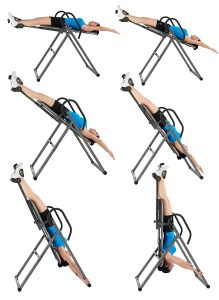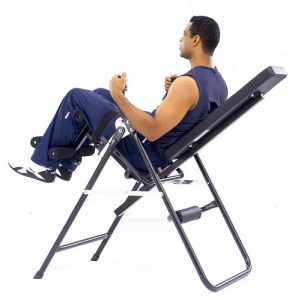Whether you’ve already built up a good athletic base and now you’re trying to take things to the next level, or you just want to get rid of nagging everyday pains, inversion therapy could be just what you need. Here’s everything you need to know about the many ways you can turn yourself upside down and the benefits of doing so.
Ways to Invert
It’s easy enough to understand the basic idea of inversion therapy. All you need to do is get into a position with your body where your heart is higher than your head. There are several common options you can try.
Inversion Tables

An inversion table is perhaps the most effective way to invert, especially if you want to do a deep inversion. The table has a board where you can lie flat, and when you first get on it, you’ll be in a position where you’re leaning back. Inversion tables allow you to either hook or secure your feet, which keeps you from sliding off, and there are also handles on each side.
You can then use the handles to tilt the board backwards and go from leaning back to inverting. The best part about inversion tables is that you can do anything from a minor inversion of 20 to 30 degrees all the way to a virtual handstand.
Inversion Chairs

An inversion chair works in the same fashion as an inversion table, except you’re in a seated position and therefore can’t invert quite as much. Inversion tables are the more versatile and dynamic option, but inversion chairs are good if you need something a bit easier on your body.
Poses

You don’t need equipment to try inversion therapy. There are quite a few inverted yoga poses out there, many of which have a low degree of difficulty and are ideal for beginners.
The standard downward dog position is a simple choice. From all fours, you extend your arms straight out while pushing up with your hands and feet, lifting your hips into the air. The result is that your body will be in the shape of a triangle.
If you have the strength for it, you can do an L-stand against a wall. You’ll start in the downward dog position with your feet against the base of the wall, and then walk your feet up that wall until you’ve turned your body into an L-shape.
Headstands are another good pose to try, and if you have trouble with it, you can get a headstand stool for support.
What Are the Benefits?
If you’re wondering why you should go to the trouble of getting yourself upside down, there are several benefits of inversion therapy.
Pain Relief
For many people, this is the biggest benefit of inversion therapy. When you invert, you’re reversing the harm gravity can do to your spine. Gravity causes your spine to compress throughout the day, which can lead to alignment issues, pain and, as you get older, a loss in height. Inverting helps you decompress your spine and alleviate aches and pains.
Heart Health
Inverting also has a positive effect on your heart, because when you do it, it’s easier for your heart to pump blood throughout your body. This can lower your heart rate.
Improves Your Breathing
When you never invert, your blood is only flowing one way, which leads to blood accumulating in some areas of the body. Inverting gets your blood going in the opposite direction that it normally does, which results in more blood flowing to your upper lungs. You’ll breathe easier and make your respiratory system stronger. Oxygenated blood will also flow into your sinuses, helping your breathing even more.
Better Posture
Inverting can do wonders for your posture. You’ll obviously benefit in terms of posture by letting your spine decompress, but that decompression will do more than just get your spine back to its full length. It will also help your muscles loosen up. Tightness in the muscles is a leading cause of postural issues. Spending a little time every day inverting could have you standing taller and looking more confident because of better posture.
Inverting Is Well Worth Your Time
With all the benefits and considering how easy it is to invert, you have every reason to make it part of your daily routine. It doesn’t take long, either, as you can invert for just a minute or two at a time.
To get the most out of inverting, you should do it on an inversion table. They offer a balance between ease of use and a nice, deep inversion that will get you maximum benefit.
Leave a Reply